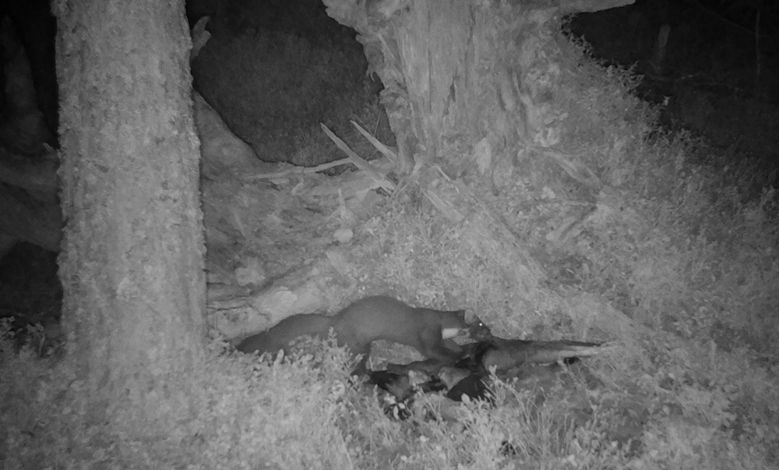
This work is the fruit of a collaboration involving Xavier Lambin, Madan Oli, Mike Begon, and the heroic, superhuman, field sampling efforts of Sandra Telfer, James MacKinnon, Isla Graham, and Sarah Burthe (Universities of Aberdeen, Florida and Liverpool).
05.10.2025 15:26 — 👍 2 🔁 0 💬 0 📌 0

Oddly, debates on the demographic phenomenon that underpin multi-annual cycles have largely taken place in the absence of demographic data. The prediction that variation in predation rate should cause variation in survival rate over population cycles had remained untested. We refuted it strongly.
05.10.2025 15:26 — 👍 3 🔁 0 💬 1 📌 0

a figure showing population growth rates in different seasons and phases of cycles and the contributions of variation in survival and recruitment rates to variation in population growth rate between cycle phases
We analysed 10 years of capture recapture data collected monthly, spanning all seasons and phases of 3 population cycles. We estimated survival and recruitments rate and their contributions to changes in population growth rate between cycles phases in early, mid, late breeding seasons and winter.
05.10.2025 15:26 — 👍 0 🔁 0 💬 1 📌 0

a field vole Microtus agrestis
For 101 years, ecologists have sought to explain the 3-4 years multi-annual cycles of voles and lemmings. In our paper, doi.org/10.1073/pnas..., we find that Density-dependent recruitment, but not survival drives cyclic dynamics in a field vole population, overturning accepted wisdom.
05.10.2025 15:26 — 👍 22 🔁 11 💬 1 📌 0
Hello Could you please add me to the science feed as contributor. My googdcholar page is scholar.google.co.uk/citations?us...
05.10.2025 14:54 — 👍 0 🔁 0 💬 0 📌 0
New perspective out today in @jappliedecology.bsky.social.
We reflect on co-producing evidence in an effort to bridge the implementation gap, for evidence based, impact focused predator control.
What worked, what didn't and where barriers to implimentation still remain.
You can't win them all... 🧪
31.07.2025 09:20 — 👍 3 🔁 5 💬 1 📌 1

🚨 New publication 📝
Out today in the royal society proceedings B. We find that diversionary feeding boosts productivity of cappercaille from 0.82 to 1.90. Indicating that this impact based method can effectively reduce the influence of predation.
Read all about it here: shorturl.at/QRb76
25.06.2025 13:10 — 👍 7 🔁 4 💬 1 📌 2
I get to work with amazing people in our group, mostly extremely talented PhD students. Here is a starter pack with them all. Follow, and you wont be disappointed 🤩
go.bsky.app/HufyKhd
02.01.2025 11:47 — 👍 28 🔁 3 💬 0 📌 0
This is work led by Amber Cowans (@ambercowans.bsky.social) and co-authored by Xavier Lambin (@lambin-ecology.bsky.social), and Darragh Hare.
All great people and worth a follow ☺️
08.12.2024 12:23 — 👍 1 🔁 1 💬 0 📌 0
Funded PhD on using sighting data to identify breeding sites for predators and pollinators with a cool approach (geoprofiling) soon available with me and @deonroos.bsky.social, Lorraine Scott and @lambin-ecology.bsky.social, spread the word!
20.12.2024 07:37 — 👍 4 🔁 7 💬 0 📌 1
TAKE HOME: We argue, using several strands of evidence, that diversionary feeding is a credible alternative to lethal control of predators and shows promising signs of reversing the decline of the capercaillie in Scotland.
Read the full paper here: www.biorxiv.org/content/10.1... 7/7
14.12.2024 16:43 — 👍 9 🔁 2 💬 1 📌 1

RESULT: Diversionary feeding increased the number of hens detected with chicks, consistent with our previous work showing a decrease in nest failure. This resulted in productivity (the expected chicks per hen) increasing from 0.82 in unfed sites to 1.9 in fed sites (more than double!). 6/7
14.12.2024 16:43 — 👍 3 🔁 1 💬 1 📌 0

HYPOTHESIS: Using a 3-year landscape-scale control-treatment experiment, we predicted that the chicks per hen differed between sites that deployed diversionary feeding and sites that did. 5/7
14.12.2024 16:43 — 👍 3 🔁 1 💬 1 📌 0

METHOD: We used #cameratraps on dust baths, natural features used by capercaillie, to detect capercaillie hens and determine whether they had chicks or didn’t have chicks. We used #AI from conservation ai to detect and count hens and broods. 4/7
14.12.2024 16:43 — 👍 3 🔁 1 💬 1 📌 0

BACKGROUND: Previously, we found that DF reduced artificial nest depredation, resulting in an 83% increase in nest survival. The big question though was whether this would translate to real birds. 3/7
14.12.2024 16:43 — 👍 3 🔁 1 💬 1 📌 0
All research wouldn't be possible without my fantastic co-authors: @lambin-ecology.bsky.social, @chrissuthy.bsky.social and @kennyafc.bsky.social l!! 🙏
2/7
14.12.2024 16:43 — 👍 3 🔁 2 💬 1 📌 0

⏰New Research ⏰
We quantified the direct impact of diversionary feeding on capercaillie productivity. We show an increase in the proportion of hen with a brood in DF sites (37% -> 85%) and, as a result, a 131% increase in chicks per hen. Read more here: www.researchgate.net/publication/...
1/7
14.12.2024 16:43 — 👍 36 🔁 16 💬 3 📌 4

Join us as @QUADRATdtp PhD candidate to learn and research population dynamics, demography and dispersal, working with lovely Tawny owls,
with @Paulcaplat.bsky.social, @Chrissuthy.bsky.social and my brilliant, supportive, interactive team within UoABioSci
findaphd.com/phds/project/q…
25.11.2023 19:25 — 👍 9 🔁 2 💬 0 📌 0
Investigador #CONICET. Coordinador Programa Patagonia de Aves Argentinas. Presidente Soc. Ornitología Neotropical.
Bird Conservation International is BirdLife International's journal, promoting worldwide research and action for the conservation of birds and their habitats.
Trabajamos para la restauración y conservación de especies y ecosistemas, basados en conocimiento científico de calidad.
macatobiano.org
Dad x2 | Scientist working on the causes and consequences of biodiversity loss | Liber Ero Chair @McGillU | co-chair GEOBON | co-director QCBS | co-chair IPBES biodiversity monitoring assessment | co-founder Habitat | He/Him
UK #conservation & #forestry partnership working together to find solutions to help protect #redsquirrels, #trees & #treehealth.
Find out more: www.squirrelaccord.uk
Follow us on YouTube: https://www.youtube.com/@UKSquirrelAccord
ESBS Special Topic Network - "Joint evolution of dispersal and mating systems"
https://dispersal-mating-stn.weebly.com/
We expose how the industries fuelling the climate crisis profit from destruction, and stand with the people fighting back.
British Ecological Society's Conservation Ecology Special Interest Group ~ nurturing a network of interdisciplinary ecologists sharing the goal of conservation
https://besconservationsig.wordpress.com/
The official Bluesky for Rewilding Britain NGO 🌱 🐳
Our aim is the mass restoration of ecosystems so that nature and people can thrive.
#ThinkBigActWild #Rewilding
Quantitative Ecologist, PhD Student @uofgsbohvm.bsky.social
Applied Ecology |Bayesian statistics |Conservation |Metapopulations |Population dynamics |Spatial Ecology |Seabirds |Grouse
https://www.gla.ac.uk/pgrs/hollyniven/
Research findings and news from a long-term study of Red Deer on the Isle of Rum National Nature Reserve, Scotland. https://rumdeer.bio.ed.ac.uk/ #isleofrum #deer #reddeer #cervuselaphus #science #reddeerresearch
mammals | wildlife | ecology | movement | disease | biodiversity | demography | behaviour | distribution | modelling
News about science, research, and resources: https://ecodynizw.github.io/
Senior Research Scientist, Norwegian Institute for Nature Research | Population ecology, demography, wildlife management | Delvis integrert i det norske samfunnet | bksandercock.wordpress.com
PhD Researcher in Statistical Ecology @ University of St Andrews | Communications Officer @besclimate.bsky.social
Using genomics to understand host dispersal and vector-borne disease spread in metapopulations 🦠🧬🌍
PhD Student researching Leptospirosis in livestock in Madagascar 🇲🇬 and Tanzania 🇹🇿
University of Aberdeen 🏴
Research interests: Zoonotic disease, wildlife disease, and genetics 🧬🧫🦠👩🔬
Lecturer in stats at Abdn Uni - https://deonroos.github.io/
SUPER NERC funded PhD researcher in Ecological Statistics at the @reshiveblog.bsky.social: Increasing efficiency and accessibility of wildlife monitoring data through the use of AI and remote sensing | Sub-editor at @reshiveblog.bsky.social














